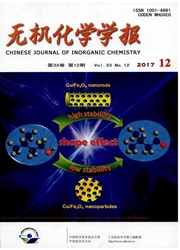

 中文摘要:
中文摘要:
水热法合成了配合物{[Ln(Hbmdc)(bmdc)(H2O)3]·3H2O}n(Ln=Eu,1;Dy,2;H2bmdc=苯并咪唑-5,6-二羧酸),用X-射线单晶衍射分析确定了配合物的晶体结构。配合物为单斜晶系,P21/c空间群。配合物1和2具有相似的一维链状结构。配体H2bmdc以2种不同的类型与Ln^3+离子配位:完全去质子化的bmdc配体和咪唑环上的氮原子被质子化的Hbmdc配体。bmdc配体的2个羧基采取双齿螯合/双齿螯合方式配位;Hbmdc配体的1个羧基采取双齿螯合方式配位,另1个羧基未参与配位。每个Ln^3+离子与6个羧基氧原子和3个水分子中氧原子配位,形成9配位的扭曲单帽四方反棱柱体。相邻的Ln^3+离子通过bmdc配体桥联形成螺旋链状结构。链和链之间通过π-π堆积和氢键进一步连接成三维超分子结构。配合物1和2分别显示Eu3+和Dy3+离子的特征荧光。
 英文摘要:
英文摘要:
The complexes {[Ln(Hbidc)(bidc)(H2O)3]·3H2O}n (Ln=Eu 1, Dy 2; H2bidc=benzimidazole-5,6-dicarboxylic acid)have been obtained by hydrothermal method and characterized by X-ray single-crystal diffraction. The two complexes belong to monoclinic system, P21/c space group. Complexes 1 and 2 have similar 1D chain structures. Ln^3+ ion is nine-coordinated by six oxygen atoms of carboxylate groups and three oxygen atom of water molecules. Ln^3+ ions are linked by bmdc ligands to form a 1D helical chain. The right- and left-handed chains are further connected to form 3D network via interchain hydrogen bonds and π-π stacking interactions. The two complexes behave characteristic fluorescence of Eu3+ and Dy3+ ions, respectively. CCDC: 883519, 1; 883518, 2.
 同期刊论文项目
同期刊论文项目
 同项目期刊论文
同项目期刊论文
 Facile solvothermal synthesis of monodisperse Fe3O4 nanocrystals with precise size control of one na
Facile solvothermal synthesis of monodisperse Fe3O4 nanocrystals with precise size control of one na White light emission by lanthanide doped Sm(III) framework constructed from 4-sulfobenzoate and 1H-i
White light emission by lanthanide doped Sm(III) framework constructed from 4-sulfobenzoate and 1H-i A lead(II) coordination polymer containing 2-carboxycinnamic acid and 1,10-phenanthroline and its 3-
A lead(II) coordination polymer containing 2-carboxycinnamic acid and 1,10-phenanthroline and its 3- Two-dimensional open structures of transition metal(II) coordination polymers constructed from 3-flu
Two-dimensional open structures of transition metal(II) coordination polymers constructed from 3-flu Highly Thermostable One-Dimensional Lanthanide(III) Coordination Polymers Constructed from Benzimida
Highly Thermostable One-Dimensional Lanthanide(III) Coordination Polymers Constructed from Benzimida A novel addition complex composed of single and double chains constructed from btb-Cd-SO4 units (btb
A novel addition complex composed of single and double chains constructed from btb-Cd-SO4 units (btb Effect of anions on architectures of transition metal complexes with 1,4-bis (1,2,4-triazol-1-yl)but
Effect of anions on architectures of transition metal complexes with 1,4-bis (1,2,4-triazol-1-yl)but Two cadmium(II) addition compounds with 3-hydroxy-2,7-naphthalenedisulfonate containing aromatic dia
Two cadmium(II) addition compounds with 3-hydroxy-2,7-naphthalenedisulfonate containing aromatic dia Synthesis, structure and luminescence property of 2D lanthanide complexes with 3-fluorophthalate and
Synthesis, structure and luminescence property of 2D lanthanide complexes with 3-fluorophthalate and Architectures of transition metal(II) polymeric frameworks constructed by 3- fluorophthalic acid and
Architectures of transition metal(II) polymeric frameworks constructed by 3- fluorophthalic acid and Unusual double layer coordination polymers constructed from metal(II)- 3- fluorophthalate helices an
Unusual double layer coordination polymers constructed from metal(II)- 3- fluorophthalate helices an 3D Rare earth porous coordination frameworks with formamide generated in situ syntheses: Crystal str
3D Rare earth porous coordination frameworks with formamide generated in situ syntheses: Crystal str White light emission of an Eu(III)-doped Gd(III) complex with 3-sulfobenzoate and 1H-imidazo[4,5-f][
White light emission of an Eu(III)-doped Gd(III) complex with 3-sulfobenzoate and 1H-imidazo[4,5-f][ Mononuclear manganese and tetranuclear copper compounds and their supramolecular networks constructe
Mononuclear manganese and tetranuclear copper compounds and their supramolecular networks constructe Facile synthesis of ultrasmall GdF3 nanowires via an oriented attachment growth and their luminescen
Facile synthesis of ultrasmall GdF3 nanowires via an oriented attachment growth and their luminescen 期刊信息
期刊信息
